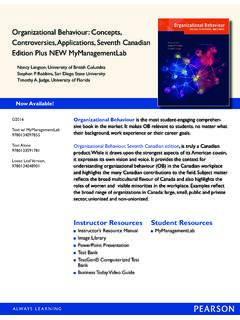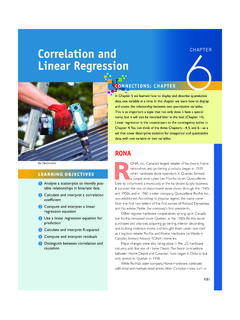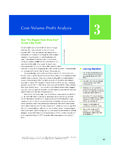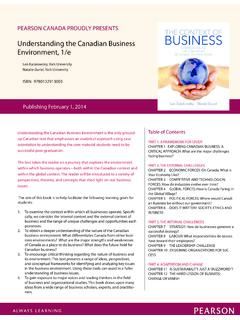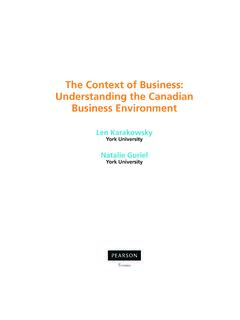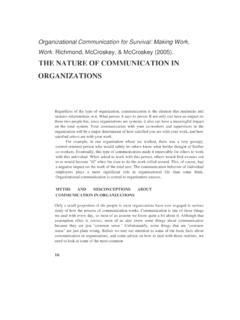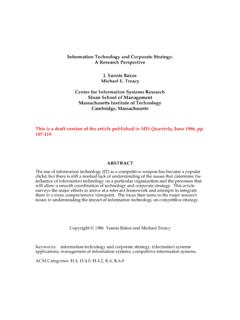Transcription of MANAGEMENT - Pearson | The world's learning …
1 MANAGEMENT i02/12/14 8:49 PM02/12/14 8:49 ii02/12/14 6:45 PM02/12/14 6:45 PM MANAGEMENT Toronto ELEVENTH CANADIAN EDITION STEPHEN P. ROBBINS SAN DIEGO STATE UNIVERSITY MARY COULTER MISSOURI STATE UNIVERSITY ED LEACH DALHOUSIE UNIVERSITY MARY KILFOIL DALHOUSIE UNIVERSITY iii02/12/14 8:49 PM02/12/14 8:49 PM Editor-in-Chief: Claudine O Donnell Acquisitions Editor: Carolin Sweig Marketing Manager: Jessica Saso Program Manager: Karen Townsend Project Manager: Jessica Hellen Developmental Editor: Suzanne Schaan Media Editor: Nicole Mellow Media Producer: Kelli Cadet Production Services: Cenveo Publisher Services Permissions Project Manager: Joanne Tang Photo Permissions Research: Krystyna Borgen, PMG Text Permissions Research: James Fortney, PMG Cover and Interior Designer: Anthony Leung Cover Image: Ken Redding/Corbis images Credits and acknowledgments for material borrowed from other sources and reproduced, with permission, in this textbook appear on the appropriate page within the text.
2 Original edition published by Pearson Education, Inc., Upper Saddle River, New Jersey, USA. Copyright 2014, 2009 Pearson Education, Inc. This edition is authorized for sale only in Canada. If you purchased this book outside the United States or Canada, you should be aware that it has been imported without the approval of the publisher or the author. Copyright 2016, 2012 Pearson Canada Inc. All rights reserved. Manufactured in the United States of America. This publication is protected by copyright and permission should be obtained from the publisher prior to any prohibited reproduction, storage in a retrieval system, or transmission in any form or by any means, electronic, mechanical, photocopying, recording, or likewise. To obtain permission(s) to use material from this work, please submit a written request to Pearson Canada Inc., Permissions Department, 26 Prince Andrew Place, Don Mills, Ontario, M3C 2T8, or fax your request to 416-447-3126, or submit a request to Permissions Requests at.
3 10 9 8 7 6 5 4 3 2 1 [CKV] Library and Archives Canada Cataloguing in Publication Robbins, Stephen P., 1943-, author MANAGEMENT / Stephen P. Robbins, San Diego State University, Mary Coulter, Missouri State University, Ed Leach, Dalhousie University, Mary Kilfoil, Dalhousie University. Eleventh Canadian edition. Revision of: MANAGEMENT / Stephen P. Robbins .. [et al.]. 10th Canadian ed. Toronto : Pearson , [2011], 2012. Includes bibliographical references and index. ISBN 978-0-13-335727-1 (bound) 1. MANAGEMENT Textbooks. 2. MANAGEMENT Canada Textbooks. I. Coulter, Mary, author II. Leach, Ed (Professor of MANAGEMENT ), author III. Kilfoil, Mary, 1956-, author IV. Title. 2015 C2014-904803-3 ISBN 978-0-13-335727-1 iv02/12/14 6:45 PM02/12/14 6:45 PMv Brief Contents CHAPTER 1 Introduction to MANAGEMENT and Organizations 1 Module 1 MANAGEMENT History 24 CHAPTER 2 organizational Culture and the organizational Environment 35 CHAPTER 3 Managing in a Global Environment 62 CHAPTER 4 Managing Entrepreneurially 87 CHAPTER 5 Managing Responsibly and Ethically 109 CHAPTER 6 Innovation and Adaptability 136 Part ONE Defining the Manager s Terrain CHAPTER 7 Decision Making 162 CHAPTER 8 Foundations of Planning 188 CHAPTER 9 Managing Strategically 207 Module 2 Planning and Control Techniques 233 Part TWO Planning CHAPTER 10 organizational Design 249 CHAPTER 11 Managers and communication 275 CHAPTER 12 Managing Human Resources 302 Part THREE Organizing
4 CHAPTER 13 Leadership 332 CHAPTER 14 Motivating Employees 359 CHAPTER 15 Managing Groups and Teams 387 Part FOUR Leading CHAPTER 16 Managerial Controls: Evidence-Based Decision Making 412 Module 3 Managing Operations 439 Part FIVE Controlling v02/12/14 6:45 PM02/12/14 6:45 PM Preface xiii Acknowledgements xvii About the Authors xix PART ONE Defining the Manager s Terrain CHAPTER 1 Introduction to MANAGEMENT and Organizations 1 Who Are Managers and Why Are They Important? 2 Datapoints 3 Who Is a Manager? 3 Types of Managers 3 What Is MANAGEMENT and What Do Managers Do? 4 Efficiency and Effectiveness 5 MANAGEMENT Functions 5 MANAGEMENT Roles 7 What Is an Organization? 9 The Size of Organizations 11 The Types of Organizations 11 How Is the Manager s Job Changing?
5 12 Importance of Customers to the Manager s Job 12 Importance of Social Media to the Manager s Job 13 Importance of Innovation to the Manager s Job 14 Importance of Adaptability to the Manager s Job 14 Importance of Sustainability to the Manager s Job 14 Why Study MANAGEMENT ? 15 The Universality of MANAGEMENT 16 The Reality of Work 16 Self-Employment 17 Module 1: MANAGEMENT History 24 Early MANAGEMENT 24 Classical Approach 25 Scientific MANAGEMENT 25 General Administrative Theory 27 Behavioural Approach 29 Quantitative Approach 30 Contemporary Approaches 32 CHAPTER 2 organizational Culture and the organizational Environment 35 The Manager: Omnipotent or Symbolic? 36 The Omnipotent View 36 The Symbolic View 36 Reality Suggests a Synthesis 37 The Organization s Culture 38 What Is organizational Culture?
6 38 Strong Cultures 41 Subcultures 41 Where Culture Comes From and How It Continues 42 How Employees Learn Culture 43 How Culture Affects Managers 44 Datapoints 45 Current organizational Culture Issues Facing Managers 45 Creating an Ethical Culture 45 Creating an Innovative Culture 46 Creating a Customer-Responsive Culture 47 Creating a Culture That Supports Diversity 48 The organizational Environment 48 Defining the External Environment 49 How the organizational Environment Affects Managers 54 CHAPTER 3 Managing in a Global Environment 62 What s Your Global Perspective? 63 Understanding the Global Environment 65 Regional Trading Alliances 65 Datapoints 69 Global Trade Mechanisms 69 The world Trade Organization 69 International Monetary Fund and world bank Group 70 Organisation for Economic Co-operation and Development (OECD) 70 Doing Business Globally 70 Different Types of International Organizations 71 How Organizations Go International 72 Managing in a Global Environment 74 vi Contents Contents vi02/12/14 6:45 PM02/12/14 6:45 PM The Legal Political Environment 75 The Economic Environment 75 The Cultural Environment 76 Global MANAGEMENT in Today s world 80 CHAPTER 4 Managing Entrepreneurially 87 The Context of Entrepreneurship 88 What Is Entrepreneurship?
7 88 How Entrepreneurial Ventures Add Value to the Economy 88 The Nature of Opportunities and the Role of Entrepreneurial Managers 89 Why Is Entrepreneurship Important? 89 What Do Entrepreneurs Do? 90 Social Responsibility and Ethical Issues Facing Entrepreneurs 92 The Entrepreneurial Process 92 Start-Up and Planning Issues for an Entrepreneurial Venture 93 Embracing Failure as learning 94 Researching a Venture s Feasibility: Generating and Evaluating Ideas 94 Researching a Venture s Feasibility: Researching Competitors 95 Researching a Venture s Feasibility: Researching Financing 96 Planning a Venture: Developing a Business Plan 96 Issues in Organizing an Entrepreneurial Venture 97 organizational Design and Structure 97 Human Resource MANAGEMENT 98 How to Stimulate and Make Changes 98 The Continuing Importance of Innovation 98 Issues in Leading an Entrepreneurial Venture 100 The Entrepreneur as Leader 101 Issues in Controlling an Entrepreneurial Venture 101 Managing Growth 102 Managing Downturns 103 Exiting the Venture 103 CHAPTER 5 Managing Responsibly and Ethically 109 What Is Meant by Socially Responsible MANAGEMENT ?
8 110 From Obligations to Responsiveness to Responsibility 110 The Evolution of Socially Responsible MANAGEMENT 113 Corporate Social Responsibility and Economic Performance 114 Sustainable MANAGEMENT Practices 115 Global Environmental Problems 116 How Organizations Manage Sustainably 116 Evaluating Sustainable MANAGEMENT 118 Values-Based MANAGEMENT 119 Purposes of Shared Values 120 Managerial Ethics 121 Factors That Affect Employee Ethics 121 Ethics in an International Context 125 Datapoints 125 Encouraging Ethical Behaviour 126 CHAPTER 6 Innovation and Adaptability 136 The Context of Innovation and Adaptability 137 Why Build an Adaptable Organization? 137 Innovation 138 Adaptability 138 Forces for Change 138 External Forces 139 Internal Forces 140 Two Views of the Change Process 140 The Calm Waters Metaphor 141 The White-Water Rapids Metaphor 142 Putting the Two Views in Perspective 142 Managing organizational Change 142 What Is organizational Change?
9 143 Types of Change 143 Global organizational Development 146 Managing Resistance to Change 146 Stimulating Innovation and Adaptability 147 Creativity vs. Innovation 148 Stimulating and Nurturing Innovation and Adaptability 149 Adaptive Organizations 152 Innovation and Design Thinking 152 Changing organizational Culture 153 Part One: MANAGEMENT Practice 161 PART TWO Planning CHAPTER 7 Decision Making 162 The Decision-Making Process 163 Step 1: Identify a Problem 163 Step 2: Identify Decision Criteria 164 Step 3: Allocate Weights to Criteria 164 Contents vii02/12/14 6:45 PM02/12/14 6:45 PM Step 4: Develop Alternatives 165 Step 5: Analyze Alternatives 166 Step 6: Select an Alternative 166 Step 7: Implement the Alternative 166 Step 8: Evaluate Decision Effectiveness 167 The Manager as Decision Maker 167 Making Decisions: Rationality 168 Making Decisions.
10 Bounded Rationality 168 Making Decisions: The Role of Intuition 169 Making Decisions: The Role of Evidence-Based MANAGEMENT 170 Types of Decisions and Decision-Making Conditions 171 Types of Decisions 171 Decision-Making Conditions 173 Decision-Making Styles 176 Linear Nonlinear Thinking Style Profile 176 Decision-Making Biases and Errors 177 Datapoints 179 Summing Up Managerial Decision Making 179 Effective Decision Making for Today s world 179 Guidelines for Effective Decision Making 180 Design Thinking and Decision Making 181 CHAPTER 8 Foundations of Planning 188 What Is Planning? 189 Planning and Performance 189 How Do Managers Plan? 190 Goals and Plans 191 Types of Goals 191 Types of Plans 191 Setting Goals and Developing Plans 193 Approaches to Setting Goals 193 Datapoints 196 Developing Plans 196 Approaches to Planning 198 Current Issues in Planning 199 How Can Managers Plan Effectively in Dynamic Environments?


